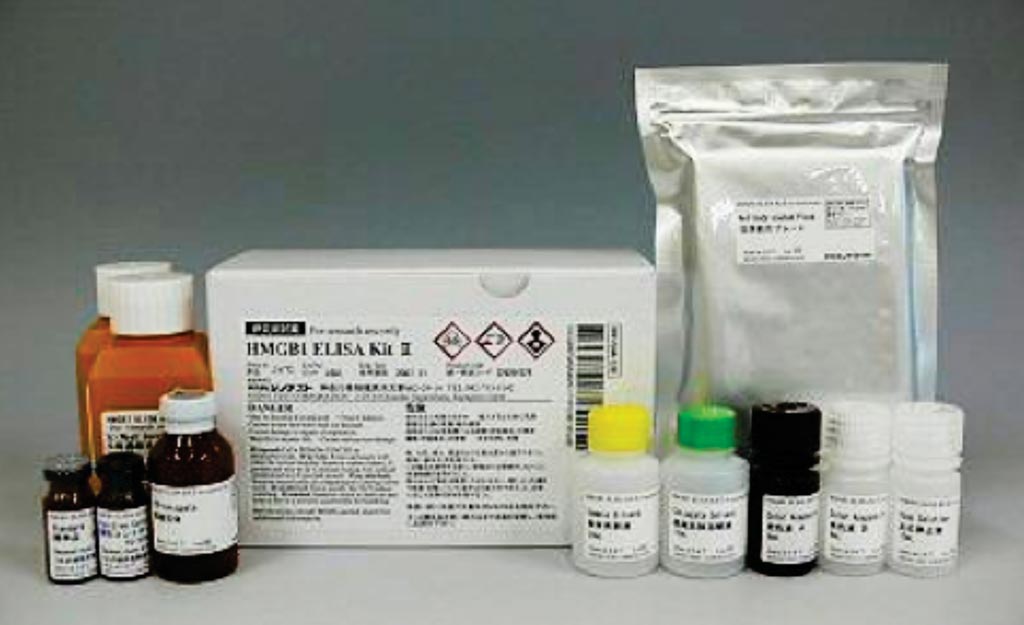Serum HMGB1 Levels Reflect Clinical Features of HLH
|
By LabMedica International staff writers Posted on 17 Sep 2019 |

Image: The High Mobility Group Box protein 1 (HMGB1) quantitative enzyme-linked immunosorbent assay kit (Photo courtesy of Shino-Test Corporation).
Hemophagocytic lymphohistiocytosis (HLH) is a life-threatening hyperinflammatory syndrome. Hypercytokinemia secreted from dysregulated hyperactivated monocytes, macrophages, T cells and NK cells has been reported to play a major role in HLH.
High mobility group box protein 1 (HMGB1) is a nonhistone nuclear protein that has a dual function. Inside the cell, HMGB1 binds DNA, regulating transcription and determining chromosomal architecture. HMGB1 can be released actively from innate immune cells in response to pathogenic products and passively from injured or dying cells.
Scientists at the Wakayama Medical University (Wakayama City, Japan) measured serum HMGB1 levels in 28 patients with HLH and six normal controls using a quantitative immunoassay. The patients were 21 boys and seven girls, aged from 10 days to 21 years, with a median age of 8.5 years. The underlying conditions of HLH were infection-associated HLH in 18 patients, malignancy-associated HLH in seven patients, and genetic HLH in three patients. The relations between serum HMGB1 levels and clinical symptoms and laboratory parameters were analyzed.
Blood samples were collected from the patients at the time of diagnosis of HLH and before specific treatment for HLH. Serial serum HMGB1 levels were measured in one patient. Whole blood collected in non-heparinized tubes was left to clot at room temperature for 30 minutes before centrifugation at 3,000 rpm for 15 minutes. The serum fractions were stored at −80 °C until the time of assay. Serum HMGB1 concentrations were determined using a quantitative enzyme-linked immunosorbent assay.
The scientists reported that serum HMGB1 levels were significantly higher in patients with HLH than in normal controls (median, 6.5 ng/mL). The serial serum HMGB1 levels in one patient fell to reflect the disease activity. Serum HMGB1 levels were significantly higher in patients with disseminated intravascular coagulation (DIC) than in patients without DIC and were also significantly higher in patients with central nervous system (CNS) complications than in patients without CNS complications. Serum HMGB1 levels were positively correlated with aspartate aminotransferase and negatively correlated with fibrinogen and hemoglobin.
The authors concluded that their study showed that serum HMGB1 levels reflect clinical features of childhood HLH. HMGB1 is a potential mediator involved in the pathogenesis and determining the clinical findings of HLH. The study was published on August 27, 2019, in the Journal of Blood Medicine.
Related Links:
Wakayama Medical University
High mobility group box protein 1 (HMGB1) is a nonhistone nuclear protein that has a dual function. Inside the cell, HMGB1 binds DNA, regulating transcription and determining chromosomal architecture. HMGB1 can be released actively from innate immune cells in response to pathogenic products and passively from injured or dying cells.
Scientists at the Wakayama Medical University (Wakayama City, Japan) measured serum HMGB1 levels in 28 patients with HLH and six normal controls using a quantitative immunoassay. The patients were 21 boys and seven girls, aged from 10 days to 21 years, with a median age of 8.5 years. The underlying conditions of HLH were infection-associated HLH in 18 patients, malignancy-associated HLH in seven patients, and genetic HLH in three patients. The relations between serum HMGB1 levels and clinical symptoms and laboratory parameters were analyzed.
Blood samples were collected from the patients at the time of diagnosis of HLH and before specific treatment for HLH. Serial serum HMGB1 levels were measured in one patient. Whole blood collected in non-heparinized tubes was left to clot at room temperature for 30 minutes before centrifugation at 3,000 rpm for 15 minutes. The serum fractions were stored at −80 °C until the time of assay. Serum HMGB1 concentrations were determined using a quantitative enzyme-linked immunosorbent assay.
The scientists reported that serum HMGB1 levels were significantly higher in patients with HLH than in normal controls (median, 6.5 ng/mL). The serial serum HMGB1 levels in one patient fell to reflect the disease activity. Serum HMGB1 levels were significantly higher in patients with disseminated intravascular coagulation (DIC) than in patients without DIC and were also significantly higher in patients with central nervous system (CNS) complications than in patients without CNS complications. Serum HMGB1 levels were positively correlated with aspartate aminotransferase and negatively correlated with fibrinogen and hemoglobin.
The authors concluded that their study showed that serum HMGB1 levels reflect clinical features of childhood HLH. HMGB1 is a potential mediator involved in the pathogenesis and determining the clinical findings of HLH. The study was published on August 27, 2019, in the Journal of Blood Medicine.
Related Links:
Wakayama Medical University
Latest Clinical Chem. News
- Blood Test Could Predict and Identify Early Relapses in Myeloma Patients
- Compact Raman Imaging System Detects Subtle Tumor Signals
- Noninvasive Blood-Glucose Monitoring to Replace Finger Pricks for Diabetics
- POC Breath Diagnostic System to Detect Pneumonia-Causing Pathogens
- Online Tool Detects Drug Exposure Directly from Patient Samples
- Chemical Imaging Probe Could Track and Treat Prostate Cancer
- Mismatch Between Two Common Kidney Function Tests Indicates Serious Health Problems
- VOCs Show Promise for Early Multi-Cancer Detection
- Portable Raman Spectroscopy Offers Cost-Effective Kidney Disease Diagnosis at POC
- Gold Nanoparticles to Improve Accuracy of Ovarian Cancer Diagnosis
- Simultaneous Cell Isolation Technology Improves Cancer Diagnostic Accuracy
- Simple Non-Invasive Hair-Based Test Could Speed ALS Diagnosis
- Paper Strip Saliva Test Detects Elevated Uric Acid Levels Without Blood Draws
- Prostate Cancer Markers Based on Chemical Make-Up of Calcifications to Speed Up Detection
- Breath Test Could Help Detect Blood Cancers
- ML-Powered Gas Sensors to Detect Pathogens and AMR at POC
Channels
Clinical Chemistry
view channel
Blood Test Could Predict and Identify Early Relapses in Myeloma Patients
Multiple myeloma is an incurable cancer of the bone marrow, and while many patients now live for more than a decade after diagnosis, a significant proportion relapse much earlier with poor outcomes.... Read more
Compact Raman Imaging System Detects Subtle Tumor Signals
Accurate cancer diagnosis often depends on labor-intensive tissue staining and expert pathological review, which can delay results and limit access to rapid screening. These conventional methods also make... Read moreMolecular Diagnostics
view channel
Blood Test Combined with MRI Brain Scans Reveals Two Distinct Multiple Sclerosis Types
Multiple sclerosis (MS) affects more than 2.8 million people worldwide, yet predicting how the disease will progress in individual patients remains difficult. Current MS classifications are based on clinical... Read more
Ultra-Sensitive Blood Biomarkers Enable Population-Scale Insights into Alzheimer’s Pathology
Accurately estimating how many people carry Alzheimer’s disease pathology has long been a challenge, as traditional methods rely on small, clinic-based samples rather than the general population.... Read more
Blood Test Could Predict Death Risk in World’s Most Common Inherited Heart Disease
Hypertrophic cardiomyopathy (HCM) is the world’s most common inherited heart condition and affects millions of people globally. While some patients live with few or no symptoms, others develop heart failure,... Read moreImmunology
view channel
Ultrasensitive Liquid Biopsy Demonstrates Efficacy in Predicting Immunotherapy Response
Immunotherapy has transformed cancer treatment, but only a small proportion of patients experience lasting benefit, with response rates often remaining between 10% and 20%. Clinicians currently lack reliable... Read more
Blood Test Could Identify Colon Cancer Patients to Benefit from NSAIDs
Colon cancer remains a major cause of cancer-related illness, with many patients facing relapse even after surgery and chemotherapy. Up to 40% of people with stage III disease experience recurrence, highlighting... Read moreMicrobiology
view channel
New UTI Diagnosis Method Delivers Antibiotic Resistance Results 24 Hours Earlier
Urinary tract infections affect around 152 million people every year, making them one of the most common bacterial infections worldwide. In routine medical practice, diagnosis often relies on rapid urine... Read more
Breakthroughs in Microbial Analysis to Enhance Disease Prediction
Microorganisms shape human health, ecosystems, and the planet’s climate, yet identifying them and understanding how they are related remains a major scientific challenge. Even with modern DNA sequencing,... Read morePathology
view channel
Genetics and AI Improve Diagnosis of Aortic Stenosis
Aortic stenosis is a progressive narrowing of the aortic valve that restricts blood flow from the heart and can be fatal if left untreated. There are currently no medical therapies that can prevent or... Read more
AI Tool Simultaneously Identifies Genetic Mutations and Disease Type
Interpreting genetic test results remains a major challenge in modern medicine, particularly for rare and complex diseases. While existing tools can indicate whether a genetic mutation is harmful, they... Read more
Rapid Low-Cost Tests Can Prevent Child Deaths from Contaminated Medicinal Syrups
Medicinal syrups contaminated with toxic chemicals have caused the deaths of hundreds of children worldwide, exposing a critical gap in how these products are tested before reaching patients.... Read more
Tumor Signals in Saliva and Blood Enable Non-Invasive Monitoring of Head and Neck Cancer
Head and neck cancers are among the most aggressive malignancies worldwide, with nearly 900,000 new cases diagnosed each year. Monitoring these cancers for recurrence or relapse typically relies on tissue... Read moreTechnology
view channel
Pioneering Blood Test Detects Lung Cancer Using Infrared Imaging
Detecting cancer early and tracking how it responds to treatment remains a major challenge, particularly when cancer cells are present in extremely low numbers in the bloodstream. Circulating tumor cells... Read more
AI Predicts Colorectal Cancer Survival Using Clinical and Molecular Features
Colorectal cancer is one of the most common and deadly cancers worldwide, and accurately predicting patient survival remains a major clinical challenge. Traditional prognostic tools often rely on either... Read moreIndustry
view channel
BD and Penn Institute Collaborate to Advance Immunotherapy through Flow Cytometry
BD (Becton, Dickinson and Company, Franklin Lakes, NJ, USA) has entered into a strategic collaboration with the Institute for Immunology and Immune Health (I3H, Philadelphia, PA, USA) at the University... Read more




















